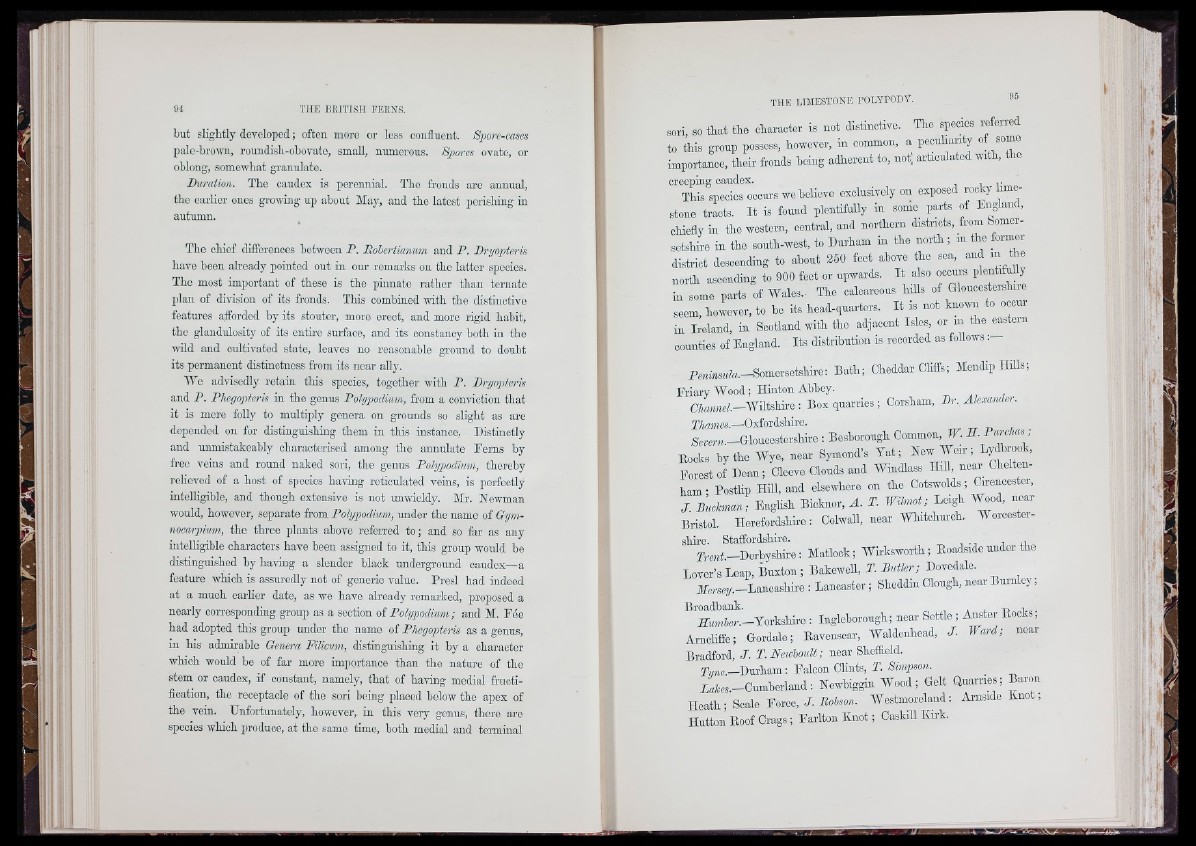
but slightly developed ; often more or less confluent. Spore-cases
palo-hroAvn, roundish-obovato, small, numerous. Sqcorcs ovato, or
oblong, somoAvhat granulate.
Duration. Tho caudox is poronnial. Tho fronds aro annual,
tho earlier ones groAving up about May, and tho latest porisliing in
autumn.
Tho chief diffcrenoos betAVOcn P . Rohertianmn and P . Dryopteris
have boon already pointed out iu our remarks on tho latter species.
The most important of these is tho pinnate rather than ternate
plan of diAdsion of its fronds. This combined Avitli tho distinctive
features afforded hy its stouter, moro erect, and moro rigid habit,
the glandulosity of its entire surface, and its constancy both in the
AA'ild and cultivated state, loaves no reasonable ground to doubt
its permanent distinctness from its near ally.
"Wo adAuscdly retain this species, together with P . Dryopteris
and P . Tlieyopteris in the genus Dolypodium, from a conviction that
it is mere folly to mxdtiply genera on grounds so slight as are
depended on for distinguishing them in this instance. Distinctly
and unmistakeably characterised among the annulate Ferns by
free A'oins and round naked sori, tho genus DolypoCiimn, thereby
relioAred of a host of species having reticulated veins, is perfectly
intelligible, and though extensive is not unAAaoldy. Mr. Nowman
Avould, however, separate from Polypoclimn, under tho name of Qym-
nocarpimn, the three plants above I’cferrod to ; and so far as any
intolligiblo characters have been assigned to it, this group would be
distinguished hy having a slender black underground caudox—a
feature Avhioh is assuredly not of generic value. Prosl had indeed
at a much earher date, as wc have already remarked, proposed a
nearly corresponding group as a section of Pohjpodium; and M. Fée
had adopted this group under the name of Plieyopteris as a genus,
in his admirable Genera Filicum, distinguisbing it by a character
AA’hioh would be of far more importance than the nature of the
stem or caudex, if constant, namely, that of having medial fructification,
the receptacle of the sori hoing placed boloAV tho apox of
tho vein. Unfortunately, hoAvever, in this very genus, there aro
species which produce, at the same time, both medial and terminal
t h e lime sto n e po lypo d y . 05
sori, so th a t the character is not distinctive. The spoaos refonod
to this group possess, however, in common, a peculiarity of some
importance, their fronds hoiug adherent to, not] articulated AVitli, the
creeping caudex. .
This spccios occurs wc believe exclusively on exposed rooky limestone
tracts. I t is found plentifully iu some parts of Fnglund,
chiefly iu tho western, central, and northern districts, from Somersetshire
in the sonth-AVOst, to Durham iu the n o rth ; in the foimci
district descending to about 250 feet above tho sea, and in Ue
north ascending to 900 foot or upwards. I t ffiso occurs y
iu some parts of Wales. The calcareous hills of Glouccstershiio
seem, however, to ho its head-quartcrs. I t is not known to occur
in Ireland, in Scotland with tho adjacent Isles, or in the castein
counties of England. Its distribution is recorded as follows
P 5 „i«s«fa.-Somersetshire: Bath; Cheddar CHffs; Mendip Hills;
F r ia ry Wood; Hinton Abbey.
Wiltshire : Box quarries ; Corsham, Dr. Alexander.
T/iffiwcs.—Oxfordshire. -rrr tt -n i
g,,,,„,_Glonoestershirc : Boshorough Common, W. H. Purehas
Hocks by the Wye, near Symond’s Y a t; Noav Weir ; Lydbrook,
Forest of Dean; Cleeve Clouds and Windlass Hill, nem- Cheltenham
• Postlip Hill, and elsewhere on tho Cotswolds ; Cirencester,
U. Buekman; English Bicknor, A . T. Wilmot; Leigh Wood, near
Bristol. Herefordshire: Colwall, near Whitchurch. Worcestershire.
Staffordshire.
Tren t.-D o rh jsh b e : Matlock; Wirksworth; Eoadside under the
Lover’s Leap, Buxton; BakowoU, Y.Dwi!fer; Dovodalc.
ilerse?/.—Lancashire : Lancaster; Sheddin Clough, near Bum ej ,
Broadbank. * -r. .
Humber.—Yorkshire : Ingleborough; near Settle ; Anstor Hoc ,
Arncliffe; Gordale; Eavonsoar, Waldcnhead, J. Ward; near
Bradford, J . T. Newloult; near Sheffield.
-D u rh am : Falcon Clints, T. Simpson.
Lafos.-Cumberlaud: NoAvbiggiu Wood; Gelt Quarries; Baron
H e a th ; Scale Force, J . Bobson. Westmoreland: Arusidc Knot;
Hutton Eoof Crags; Farltou K n o t; Caslull Kirk.
!if -
I
'•‘k
■ ii